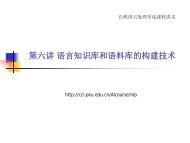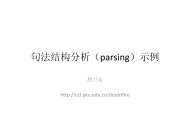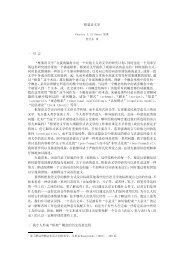A New Perspective On Chinese ZIJI
A New Perspective On Chinese ZIJI
A New Perspective On Chinese ZIJI
Create successful ePaper yourself
Turn your PDF publications into a flip-book with our unique Google optimized e-Paper software.
(4) Zhangsani zhidao<br />
Zhangsan know<br />
ziji i= j=k]].<br />
self<br />
`Zhangsani knows that you think that Wangwu likes<br />
himself/*you/*himi most.'<br />
[nij renwei [Wangwuk zui xihuan<br />
you think Wangwu most like<br />
(5) Zhangsani shuo [woj zhidao [Lisik chang piping ziji i= j=k]].<br />
Zhangsan say I know Lisi often criticize self<br />
`Zhangsani said that I feel that Lisi often criticizes<br />
himself/*me/*himi.' This complex of properties { subject orientation together with the<br />
potential for LD binding subject to unlike-person blocking has been<br />
widely regarded as evidence for a successive association between ziji (or<br />
simplex re exives in general) and superordinate subjects. According<br />
to many such accounts (e.g. Battistella (1989) Cole et al. (1990)<br />
Reinhart and Reuland (1991, 1993)), the simplex re exive, which is<br />
considered to be an X 0 category devoid of inherent phi-features, must<br />
undergo head movement to the local I at LF, with possible successivecyclic<br />
movement to a higher I. Because of Spec-head agreementbetween<br />
each I and its corresponding subject, it follows that no intervening<br />
subject can have phi-features distinct >From those of the antecedent.<br />
According to one variant ofthisaccount, due to Progovac (1992, 1993),<br />
the successive relation is not head movement, but rather an Agr-chain<br />
according to another (Huang and Tang 1991), the movement in question<br />
is not head movement but rather adjunction to IP.<br />
These accounts do not all haveidentical consequences. For example,<br />
Huang and Tang note that subject orientation is not a consequence of<br />
their analysis, speculating { as our analysis will entail { that subject<br />
orientation and morphological simplicity of re exives are independent<br />
properties. As they point out, <strong>Chinese</strong> complex re exives such astaziji<br />
`himself/herself', which have inherent phi-features and preclude LD<br />
binding, are nevertheless subject-oriented:<br />
(6) Zhangsani songgei Lisij yizhang ta-zijii= j de xiangpian.<br />
Zhangsan give Lisi one-CLA he-self DE picture<br />
`Zhangsani gave Lisij a picture of himselfi= j.'<br />
(7) Zhangsani gaosu Lisij Zhangsan tell Lisi he-self<br />
ta-ziji i= j<br />
de shenshi.<br />
DE life-story<br />
'Zhangsan i told Lisi j the story of his i= j life.'<br />
This point poses a challenge for I-to-I accounts, whether couched in<br />
terms of movement (e.g., Cole et al. 1990 Reinhart and Reuland 1991,<br />
1993) or of chains (Progovac 1992, 1993).
















